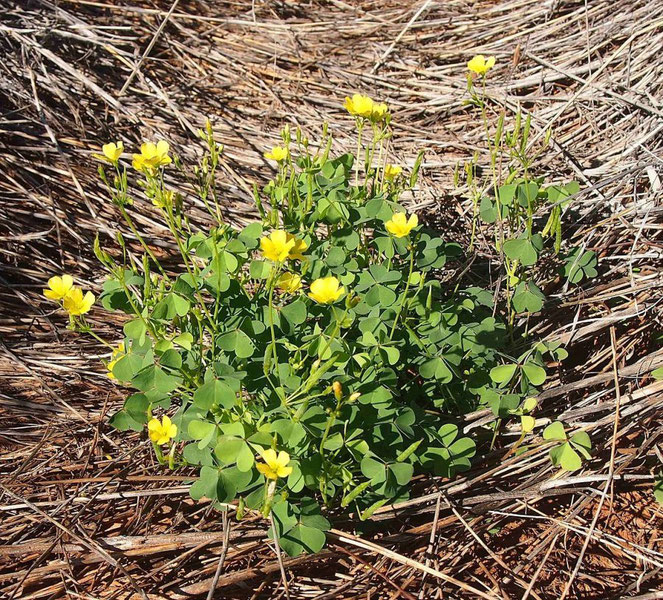Oxalis corniculata
 Image: Mark Marathon
Image: Mark Marathon
Description
Oxalis corniculata, the creeping woodsorrel, also called procumbent yellow sorrel or sleeping beauty, resembles the common yellow woodsorrel, Oxalis stricta. It is a somewhat delicate-appearing, low-growing, herbaceous plant in the family Oxalidaceae. It has a narrow, creeping stem that readily roots at the nodes. The trifoliate leaves are subdivided into three rounded leaflets and resemble a clover in shape.This species is cosmopolitan in that occurs in many climates around the world from Ethiopia to Sri Lanka to Venezuela to Australia. It is likely present in every country, although not yet reported as such. It is weedy in that it is "readily self-pollinated, producing copious seeds in a short time, and being capable of growing rapidly in open places" Its global distribution has been "partly accidental and partly deliberate, since its oxalic acid-containing leaves have long been used for culinary purposes, and for their medicinal and herbal value."
This weed is very low growing and is not described as interfering with crop production or native plants so its removal is likely cosmetic rather than practical. It is poisonous to hungry livestock exposed to dense stands of this plant, that form crystals in the kidneys, cause trembling and potentially death within hours.
Its main dispersal is by seed, as the roots do not spread widely.
Medicinal value:
The leaves of O. corniculata can be used raw or cooked, added to salads, cooked as a potherb with other, milder flavoured greens or used to give a sour flavour to other foods (PFAF, 2013).
The following medicinal uses are described by PFAF (2013):
"The whole plant is anthelmintic, antiphlogistic, astringent, depurative, diuretic, emmenagogue, febrifuge, lithontripic, stomachic and styptic. It is used in the treatment of influenza, fever, urinary tract infections, enteritis, diarrhoea, traumatic injuries, sprains and poisonous snake bites. The juice of the plant, mixed with butter, is applied to muscular swellings, boils and pimples. An infusion can be used as a wash to rid children of hookworms. The plant is a good source of vitamin C and is used as an antiscorbutic in the treatment of scurvy. The leaves are used as an antidote to poisoning by the seeds of Datura spp, arsenic and mercury. The leaf juice is applied to insect bites, burns and skin eruptions. It has an antibacterial activity.'
A number of scientific studies on the chemical constitution of O. corniculata seem to support the medicinal claims made for this species. Kumar et al. (2012) reviewed the literature on the subject and concluded that the herb should be studied more extensively for its therapeutic benefits. Das et al. (2012) tested the possible heptaprotective activity of extracts on rats and found that they seemed to show dose dependent reduction of necrosis induced by thioacetamide."
Propagation instructions - seeds
Hand removal followed with herbicide or a thick layer of mulch to cover seeds and prevent them from germinating. Mowing or grazing is not effective.
Sources and references
Scientific name
Oxalis corniculata
Common name(s)
Creeping Sorrel
